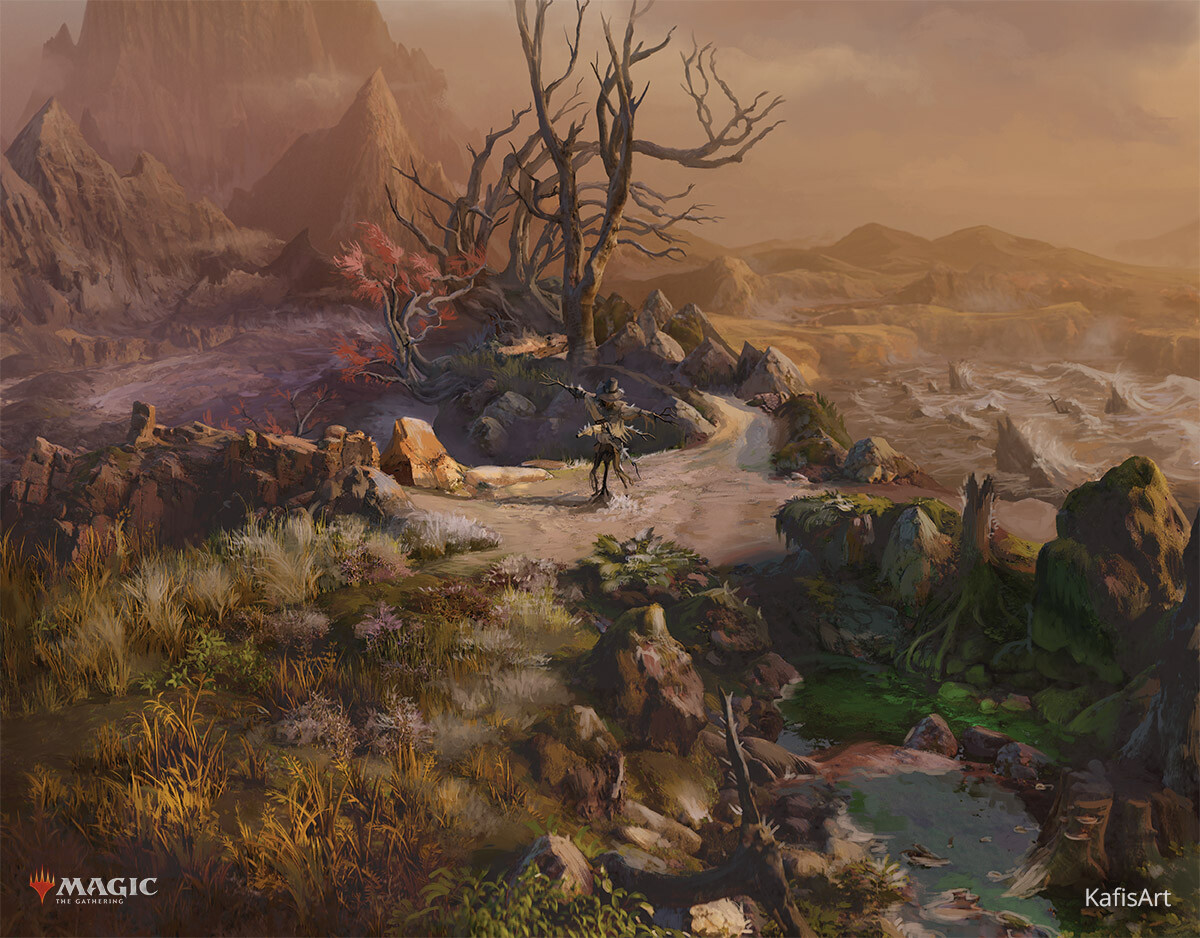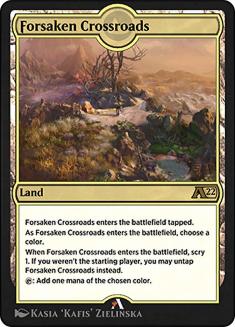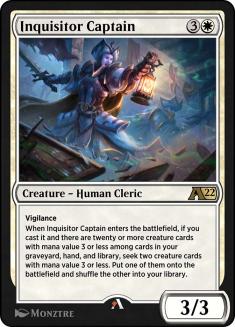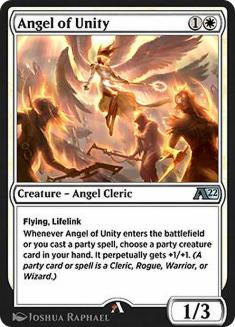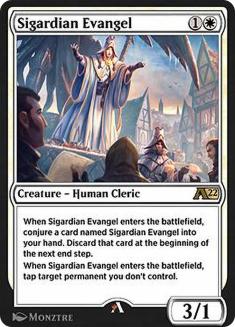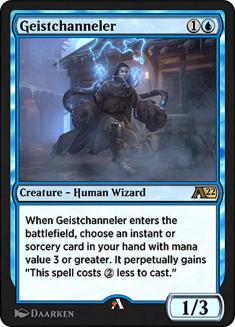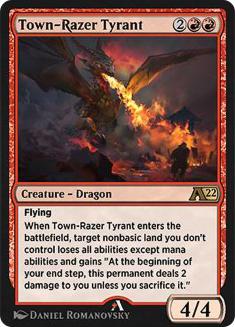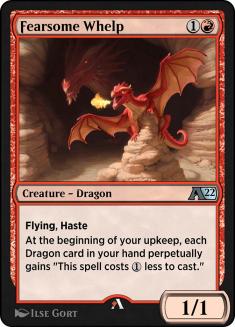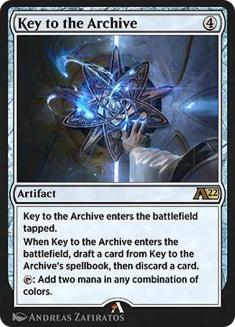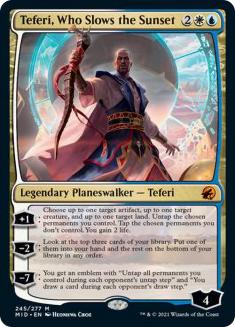Alchemy caught everyone a bit off-guard. We were there just minding our own business and complaining about Alrund’s Epiphany in Standard when we were hit with not only an entirely new set but an entirely new format, where certain cards work differently from in other formats for what I believe is the first time in Magic history. The nerf to several of Standard’s most powerful cards opened up space for new contenders to shine, and several of the new digital-focused Alchemy cards seem up to the task. We don’t know for sure what the Alchemy format is going to look like, as it’s still in its infancy and there’s a lot of exploring to be done, but here are some of the early contenders for most influential cards in the set.
1. Forsaken Crossroads
The mana in Standard has been a bit sketchy lately, but Forsaken Crossroads is a huge improvement to basically any multicolored deck. If you’re on the play, you get a “Pathway-Temple,” except you get to choose any color (so it’s better than a Pathway for mana fixing if your deck has more than two colors, but worse than a Temple if you’re exactly two), and if you’re on the draw you get a super-Pathway that has the option of being a Temple if you want the scry anyway. Knowing that you can just jam four of those in your deck and that you won’t run the risk of falling too far behind if you’re on the draw is huge!
One downside of this card, however, is that as far as I can tell there’s no easy way to know who started the game. In Games 2 and 3 you will usually know, but if it’s late in Game 1, you might have this card and not know if it’s gonna enter the battlefield untapped or not until you play it, which might then be too late. I wish the card’s text highlighted itself in some way if that part of the ability was on.
Nevertheless, I expect this card to become the most-played card in Alchemy, as any multicolored deck will want it and many of those will want the full four copies. I don’t have a decklist for it, since it can go anywhere, but you will see a lot of it throughout the rest of the article.
2. Inquisitor Captain
Inquisitor Captain is Alchemy’s take on Collected Company. The two cards are remarkably similar; they’re both four-mana cards that produce two bodies and give you some measure of control over what you’re getting, and they both require a very high creature count, though one is much more explicit about it. That said, there are pros and cons to both of them.
One pro for Collected Company is that it’s an instant; you can use it to play around sweepers and even to punish attacks with surprise blockers. Another pro is that it lets you hit two different key cards, as opposed to forcing a 3/3 with vigilance. If you’re playing something like Elves, for example, you’re not going to be interested in a random 3/3 nearly as much as you’d be on a Lord or just an extra Elf, and decks like Jund Company were always interested in finding two utility creatures.
The biggest pro for Inquisitor Captain is that it can never miss. In a deck with 24 targets, which I think is enough for Captain most of the time, you’re going to miss on finding two creatures with Company 20% of the time. This means Collected Company requires higher creature counts, and even at 30 creatures, which is a lot, you’re 10% to only find one.
Obviously Inquisitor Captain can miss since it doesn’t count cards in exile or in the battlefield. This is a bit puzzling to me; I’d think the card would be much simpler if it said “if your deck started with X creatures that cost 3 or less,” but right now you sort of have to pay attention if people have exile effects or if your battlefield is too big, and you need to be aware of keeping your creature count high after sideboarding (though in reality this is likely to produce better sideboarding as people historically always butchered their Collected Companies in Games 2 and 3). That said, it should happen much more rarely (you might run into graveyard hate or something like Tasha’s Hideous Laughter), and you always know (or you should in theory know) if it’s going to happen or not before you play the Captain.
The biggest pro of the Captain compared to Collected Company is that it’s an “enters the battlefield” trigger. This means it’s abusable with copy effects and blink effects, many of which can be found with the Captain ability itself. We don’t have a critical mass of effects to guarantee this chain just yet (since you need even more cards, as the ones in the battlefield don’t count — maybe that’s why it works this way?), but things like Charmed Prince, Glasspool Mimic and Soulherder all work to give you an extra spin.
Of course, Inquisitor Cleric has an extra advantage over Collected Company that’s pretty much insurmountable — it’s legal in Alchemy! It doesn’t have to be better than Company because it’s the card you can actually play in the format. So where do we want to play it in Alchemy?
You see, Inquisitor Captain also happens to be a Cleric — one of my favorite creature types. I’ve been (very unjustly, I might add) accused of “trying to make Clerics happen” too much in the past format, but with Inquisitor Captain they really might happen, because that deck is interested in both the bodies and the abilities that they bring. If you play Turn 3 Righteous Valkyrie at twenty life, on Turn 4 you could cast Inquisitor Captain, hit a four-toughness Angel, and already get yourself to 27 life to turn the Valkyrie on! Add that to some new Clerics in Alchemy: Innistrad (Angel of Unity and Sigardian Evangel) and we might have ourselves a real deck!
Creatures (32)
- 1 Legion Angel
- 4 Cleric of Life's Bond
- 1 Skyclave Cleric
- 4 Righteous Valkyrie
- 3 Elite Spellbinder
- 4 Lunarch Veteran
- 4 Voice of the Blessed
- 4 Angel of Unity
- 4 Inquisitor Captain
- 3 Sigardian Evangel
Lands (23)

Alternatively, you can eschew black altogether and play Glasspool Mimic, which is traditionally quite good with the Angels that scale well in multiples:
Creatures (34)
- 3 Linvala, Shield of Sea Gate
- 1 Legion Angel
- 1 Skyclave Cleric
- 4 Glasspool Mimic
- 4 Righteous Valkyrie
- 2 Elite Spellbinder
- 4 Lunarch Veteran
- 4 Voice of the Blessed
- 4 Angel of Unity
- 4 Inquisitor Captain
- 3 Sigardian Evangel
Lands (22)

If you add blue, you also get Linvala, Shield of Sea Gate. Between that, Glasspool Mimic, and our one copy of Legion Angel, we can even achieve a full party!
3. Geistchanneler
I’m not sure how good Geistchanneler is, but it strikes me as at least interesting enough to try. Combo decks in the past have run Pentad Prism, and in certain situations it’ll be as good as Pentad Prism for accelerating while also coming with a 1/3 blocker attached, which could buy you an extra turn or two (or perhaps act as sacrifice fodder if you’re playing a deck that can make use of that where one body is worth something to you). Obviously it’s not the same, as it only reduces colorless mana and you need to have the card in your hand already, but it’s similar enough that I think it’s worth investigating.
The first potential home for Geistchanneler is everyone’s favorite deck, Izzet Epiphany. The deck is severely nerfed, but it still goes over the top of everyone — it’s just now a bit more expensive to do that, which means Geistchanneler could be a big help, though you have to time it well with the foretell cards.
Geistchanneler has other applications that aren’t just making Alrund’s Epiphany cheaper; in fact, it might be even better at making Unexpected Windfall cheaper because then you get to combo that with Galvanic Iteration on Turn 4. Geistchanneler also enables one-mana Divide by Zero in key turns, among other things.
Here’s my current attempt:
Creatures (3)
Lands (22)
Spells (35)

I’m playing some other Alchemy: Innistrad cards as one-ofs to try out, but I’m not sure they’re good yet. I also cut the two Goldspan Dragons from the sideboard now that they’ve been nerfed. This is a Best-of-Three version, but if you play Best-of-One, then feel free to go nuts with the sideboarded Lessons.
Also, this deck is only playing two Forsaken Crossroads, but this might be a mistake. I didn’t want to overload it with lands you need to play early in the game, as it already has all the modal double-faced cards, but I need to test it a little more to see what the right number is, as I think the scrying can be quite valuable here (more so than the fixing).
4. Town-Razer Tyrant
Four mana 4/4 flyers used to be a big thing, but nowadays we have so many of those that they have lost the appeal a little bit. That said, it’s still a solid statline. Jean-Emmanuel Depraz used Moonlight Regent to great effect on his way to becoming a Worlds finalist, and a lot of what it was doing there was just being a 4/4 flyer for four with the creature type Dragon.
Town-Razer Tyrant reads extremely well and plays a bit worse in practice, but I think it’s still good enough to see play. The key is that its ability is much worse than either ability would be individually — both destroying a land and dealing two damage a turn would be broken, but you get their choice of it, and it’s a choice they get to make every turn, so it’s not as broken as it might appear initially but still strong.
Most of the time, the play pattern with Town-Razer Tyrant will be that they’ll take some damage early on — adding up to four or six damage — and then the land will go. This means this card is better than a 4/4 flyer with haste for four most of the time, as it’s going to deal the damage even it they kill it immediately, and then it’s still going to destroy a land. Many decks will have no use for a land on Turns 6 or 7, but some decks (like Izzet) want as many lands as they can get their hands on, so destroying a land even later in the game will have its uses.
There will be, of course, the outlier scenarios where it’s Turn 8 and no one cares about a land, so this just becomes a vanilla 4/4 flyer, or the scenarios in which they can afford to take ten damage and kill you anyway without ever losing the land, but then, if your four-mana card was a 4/4 that dealt ten damage and you still couldn’t win, there was probably not a lot of hope for you.
It’s also important to note that, even though this doesn’t destroy the land outright, it does turn it into a basic. If your opponent has creature-lands, they don’t have the option of keeping them “alive” for two damage — all they’re getting is the mana even if they’re willing to pay the life for it. This can also be relevant against Field of Ruin if you’re the person with the creature-lands.
Ultimately, I think what might make this card even stronger is that there’s now a critical mass of playable Dragons (even though Goldspan Dragon was just nerfed). This makes cards like Orb of Dragonkind playable, and with Fearsome Whelp we can actually have a proper Dragon tribal deck. Here’s a sketch:
Creatures (26)
- 2 Magda, Brazen Outlaw
- 4 Goldspan Dragon
- 2 Inferno of the Star Mounts
- 4 Moonveil Regent
- 4 Reckless Stormseeker
- 4 Fearsome Whelp
- 4 Town-Razer Tyrant
- 2 Rahilda, Wanted Cutthroat
Lands (22)
Spells (12)

This list might be a little too streamlined, but I wanted to focus as much as possible on the Dragons to figure out how good they were. In reality, you’ll probably want a little more interaction.
5. Key to the Archive
When I went through the set list for Alchemy: Innistrad, I kept half-heartedly clicking to check what each card’s spellbook was. Most of the time, they were all mediocre effects that were nice bonuses but nothing to write home about. When I got to Key to the Archive, I expected it to draw me my choice of Biblioplex Assistant or Dungeon Map. Instead, I found Demonic Tutors, Time Warps, and Lightning Helixes.
Obviously you don’t choose what you’re getting, but you’ll almost always find something worth drawing. If you happen not to, you just discard that card and enjoy your artifact. Sometimes, however, it will draw you the only card in Magic that would win you the game. It will feel like playing Hearthstone’s Zephrys the Great.
I don’t think you should play Key to the Archive only for its spellbook, but it’s not hard to find a deck that wants to make use of two extra mana of any combination of colors (and here it being any combination is important, because it allows you to cast off-color gold cards like Putrefy and Lightning Helix). Izzet Epiphany decks are already playing Unexpected Windfall, and that costs four mana and generates two. Obviously they’re different cards, and this not being copyable with Galvanic Iteration means you need to build your deck very differently, but at least it shows us there’s a market for accelerating from four to seven mana. Hullbreaker Horror, in particular, is a big winner from that and can even bounce the Key to the Archive if you want to try to find something new.
Key to the Archive is also very good with Teferi, Who Slows the Sunset.
Teferi’s ability allows you to untap both a land and an artifact, which means it can generate three extra mana with Key to the Archive. I’ve seen some Jeskai decks with this combo going around, most of them eschewing Alrund’s Epiphany altogether, and while this is definitely a direction you can take, I’m actually more interested in Bant versions.
I was a big fan of Bant deck based around Storm the Festival decks earlier last format, though they ended up not panning out at all in large part due to their vulnerability to Alrund’s Epiphany, which is now a much weaker card. Is Key to the Archive the card that can revitalize these builds? I think it’s possible. They can use the mana, they can use the tutored cards, and they can also find other copies of the Key with the Festival. Here’s a sketch:
Creatures (15)
- 2 Skyclave Apparition
- 4 Tangled Florahedron
- 2 Prosperous Innkeeper
- 3 Briarbridge Tracker
- 4 Rootcoil Creeper
Planeswalkers (7)
Lands (26)
Spells (12)

Overall, I’m not sure which of these decks are good yet, but I am sure that the Alchemy: Innistrad cards are very strong. It feels like the current Alchemy: Innistrad cards we have are, on average, of a much higher power level than those from both Innistrad sets, so I expect this format to diverge a lot from regular Standard the more cards are introduced to it, if it doesn’t do so already.
Whether this is a good or a bad thing is hard to tell for now, but I’m hoping it’s good!

